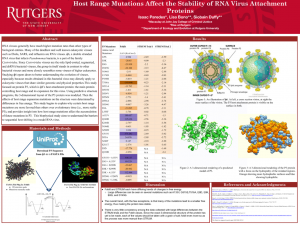Paredes, Isaac: Host Range Mutations Affect the Stability of RNA Virus Attachment Proteins
Title: Host Range Mutations Affect the Stability of RNA Virus Attachment Proteins
Name: Isaac Paredes
Home Institute: Macaulay Honors at John Jay College of Criminal Justice
Programs: RISE program
Other contributors: Siobain Duffy, Lisa Bono
Abstract: RNA viruses generally have much higher mutation rates than other types of biological entities. Many of the deadliest and well known eukaryotic viruses such as Ebola, SARS, and influenza are RNA viruses. ɸ6, a double-stranded RNA virus that infects Pseudomonas bacteria, is a part of the family Cystoviridae. Since Cystoviridae viruses are the only lipid-coated, segmented, and dsRNA bacterial viruses, the group in itself stands in contrast to other bacterial viruses and more closely resembles some viruses of higher eukaryotes. Studying ɸ6 opens doors to better understanding the evolution of viruses, especially because results obtained in this bacterial virus may directly apply to eukaryotic viruses that share similar genomic and physical properties.This study focused on protein P3, which is ɸ6’s host attachment protein: the main protein controlling host range and its expansion for this virus. Using predictive structure programs, the 3-dimensional layout of the P3 protein was modeled. Then the effects of host range expansion mutations on the structure were determined by differences in free energy. This study begins to explain why certain host range mutations are more favored than others over evolutionary time (i.e., more stable P3), and provides insight into how host range mutations affect the accumulation of future mutations in P3. This biophysical study aims to understand the barriers to sequential host shifting in a model RNA virus.
Biography: I am Isaac Paredes, a rising senior in the New York City Macaulay Honors program at CUNY John Jay College of Criminal justice majoring in cellular/molecular biology. I hope to pursue a Ph.D. in ecology and evolution with a focus in reintroduction biology as I am interested in the field’s applicability to conservation and de-extinction/restoration.
